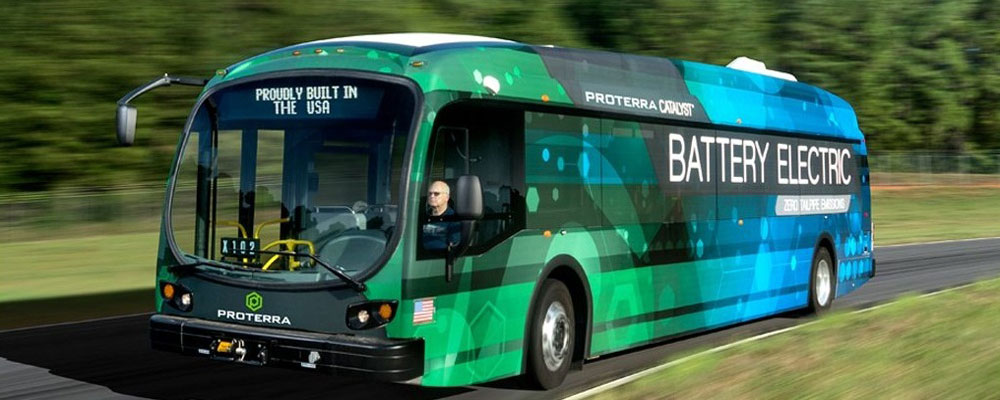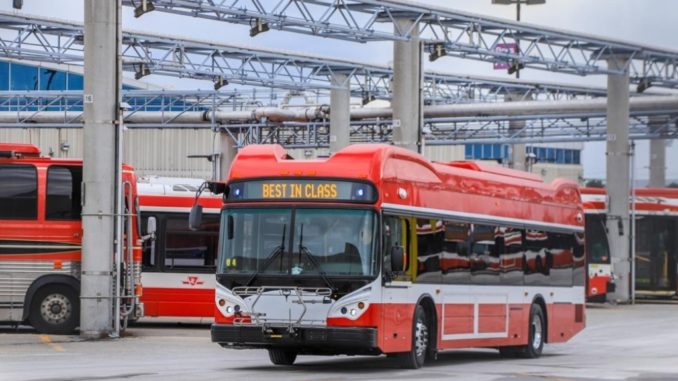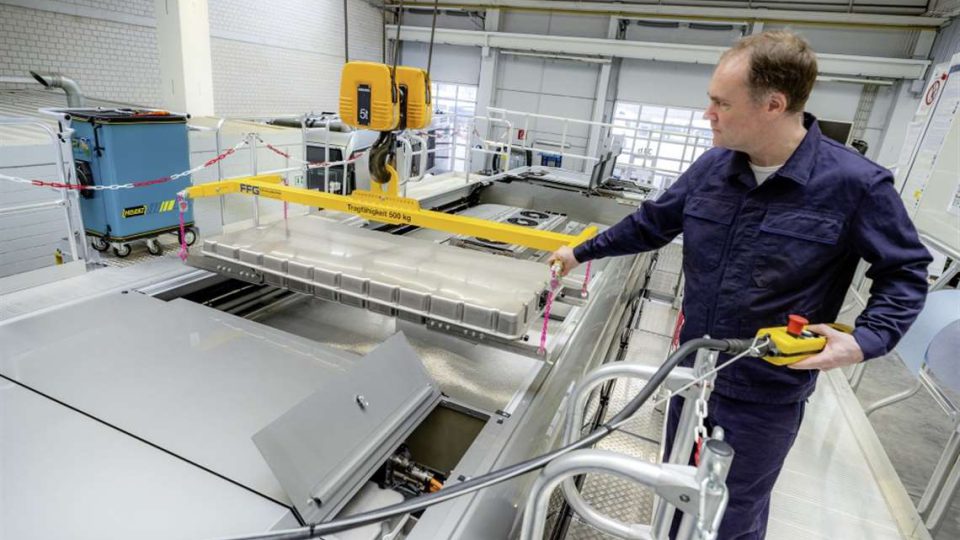«North American e-bus market is ready to take off». Interview with Dan Raudebaugh (CTE)
The electric bus market in North America is still nascent. Commitments to energy transition taken by states and municipalities are beginning to become numerous (California leading the way), and the coming years will be decisive for the deployment of large fleets of electric buses on the streets. Challenges, barriers, opportunities and trends in the evolution […]

The electric bus market in North America is still nascent. Commitments to energy transition taken by states and municipalities are beginning to become numerous (California leading the way), and the coming years will be decisive for the deployment of large fleets of electric buses on the streets.
Challenges, barriers, opportunities and trends in the evolution of the region’s zero emission bus market, as well as the roles of school buses and coaches, pro and cons of hydrogen drives, are the topics of our talk with Dan Raudebaugh, Executive Director for the Center for Transportation and the Environment (CTE), a nonprofit organization active in the support and implementation of less polluting transportation technologies side by side with transit operators, industry, institutions.

Dan Raudebaugh, CTE’s Guidebook on zero emission buses
Dan Raudebaugh, CTE’s Executive Director, may you give us a picture of your organization?
«The Center for Transportation and the Environment (CTE) is a member-supported 501c(3) nonprofit organization. Our mission is to improve the health of our climate and communities by bringing people together to develop and commercialize clean, efficient, and sustainable transportation technologies. We leverage our expertise in engineering, planning, and project management to make zero-emission vehicles a reality – for the greater good. We work with fleet operators, vehicle technology manufacturers, and decision-makers to improve how people move».
— SUSTAINABLE BUS MAGAZINE #2 HAS BEEN JUST RELEASED.READ IT IN ONE CLICK! —
Would you be willing to outline the key findings of the ‘Guidebook for Deploying Zero-Emission Transit Buses’?
«The ‘Guidebook for Deploying Zero-Emission Transit Buses’ was funded by TRB and written by Meredith Linscott and Amy Posner. It is designed to not only educate transit agencies on current best practices for zero-emission bus deployments but also to ensure that other non-profit and engineering firms that are providing technical assistance in this space utilize a consistent and effective approach. Every zero-emission bus deployment must be tailored to each transit agency’s specific needs, priorities, and available resources. The guidebook is not an instruction manual; rather it takes users through each phase of a zero-emission bus deployment with the goal of maximizing benefits and mitigating risks. The guidebook is based on CTE’s lessons learned from previous deployments, CTE’s in-house expertise, and the expertise of industry stakeholders. The publication will deepen transit operators’ understanding of ZEB technology and support decision-making. It also emphasizes the importance of collaboration with technology providers, utility companies, fuel suppliers, and contractors.
In my not so humble opinion, CTE is the only organization in the country that could write this guidebook. I say that for two reasons. First, we have by far the most experience in this field, managing zero-emission bus deployments for more than 70 transit agencies across the US and Canada in addition to developing another 25 full fleet transition plans for clients across the US. Second, CTE is a non-profit engineering and planning firm that is mission-focused, so we are happy to share this vital information with our competitors as well as transit operators across the US. We are much more interested in getting the job done right and advancing the industry than we are in gaining more and more market share. I am very proud of the work we did to put this guidebook together and of the fact that we are willing to share this information with everyone».

According to your view of the sector, which consequences should we expect from the Coronavirus-related crisis on public transport and electrification?
«Well, there is no doubt that the immediate effects of the coronavirus have had a serious, immediate impact on the transit industry. First and foremost, transit operators have to find a way to keep their operations running with a drastic loss of income at the fare box and a public resistance to sharing space together—be it on a plane, a bus, or a commuter train. But I would like to bring out a few important points that we should consider in our long-range plans on the road to recovering.
First, the COVID-19 pandemic highlights the connection between air pollution and public health, as millions of Americans with respiratory illnesses are deemed at-risk to the virus. Recent research from Harvard University suggests that counties with higher levels of fine particulate air pollution will have higher levels of hospitalizations and deaths from COVID-19 (Wu, 2020). These findings align with previously known connections between exposure to particulate matter pollution and increased risk of death from respiratory and cardiovascular conditions. So yes, in the long term, zero-emission buses help reduce the public’s risks from viruses such as the coronavirus.
Next, the population across the US is becoming more and more urban every year. We see that most major metropolitan areas have run out of room to support more cars on the road. In my opinion, transit is a critical piece to long term mobility issues in major cities across the US. Zero-emission buses make transit more attractive to the rider. They are cleaner, quieter, and safer. They are almost universally preferred by drivers and passengers alike across the US. They are also much more pedestrian friendly because they are not spewing diesel exhaust all over our cities and the people that live in them.
Finally, I would love to point out something that the virus has shown all of us. After states across the US initiated lockdown policies, the reduction in vehicle traffic and resulting clean air provided us with a glimpse of the progress we can make if we focus investment and revitalization efforts on the shift to zero-emission transportation. I have friends in Los Angeles that were absolutely shocked at how clean the air was and how beautiful the city could be without the seemingly ever-present smog.
I believe we can have our clean air and our economy too. Putting Americans back to work manufacturing and deploying zero-emission vehicles could make permanent this decrease in air pollutants while restoring economic activity that has been hampered by COVID-19».
At the end of 2019, in the US «around 450 of the nearly 75,000 municipal buses on the road were e-buses», according to BloombergNEF (you can read our interview with the Head of Electrified Transport at BloombergNEF Aleksandra O’Donovan on the newly released Sustainable Bus magazine #2). According to your data, is this figure confirmed? What do you expect for the coming years?
«I think that figure is low. I think we have slightly over 1,000 zero-emission buses deployed in the US today. I think the rate of increase of that figure may slow some due to COVID, like everything else. I know several bus OEMs had plants shut down for some time. In the long term, I think this market will continue to grow rapidly. In fact, I think the transit market may be the first major vehicle market to completely switch to zero emissions».

E-bus deployment barriers according to CTE
What are the main barriers to e-bus adoption in the US?
«Zero emission buses are more expensive than their fossil fuel counterparts. This gap is largely the result of the fact they are being produced in smaller numbers and have less mature supply chains. The cost gap closes every year, however, and zero emission buses offer the promise of reaching cost parody with their diesel and CNG counterparts. Additionally, when coupled with the potential operational savings offered by these technologies, zero emission buses show strong potential to reduce life cycle costs.
I think another barrier is education. Switching to zero-emission buses is a big paradigm shift for the industry. Transit agencies have to become familiar with very different technologies than they are used to. Dealing with batteries, new infrastructure utility rates, different charging scenarios—not to mention learning about hydrogen and fuel cells— is very complicated. That is where CTE can help. Our goal is to help educate transit providers on all of these technologies and how to properly operate them. I think the guidebook will be an invaluable tool in moving the industry down the right path.
Today just a few local manufacturers offer zero emission buses in the US. Is poor competition a reason for higher prices and consequent slow deployment? Could this lead to the penetration of Asian manufacturers in the US market (provided they are compliant with ‘Buy America’)?
«That is an interesting question. I don’t see this as an issue. Forty- and sixty-foot buses (12-meter and articulated) are the mainstay of transit operations in the US. There are four major manufacturers that dominate this market in the diesel and CNG world. They are GILLIG, New Flyer, El Dorado, and Nova Bus, with GILLIG and New Flyer controlling the lion’s share of that market.
All four of those manufacturers have a battery electric bus product and two of them have a fuel cell product as well. Add to that Proterra and BYD, who only make battery electric buses and I think you have more of a choice of zero-emission bus products in transit than you do diesel and CNG products».

Dan Raudebaugh: electric coaches on the launching pad
With regards to coaches, Van Hool’s CEO told us in an interview realized one year ago: «We are developing an electric coach for the US, and not for Europe, because in the US there is a demand for this kind of vehicle». Do you see the coach field as a penetration area for zero emission vehicles?
«I agree with Mr. Van Hool. I think the zero-emission coach market in the US is about to take off. Right now, there is only one manufacturer, BYD, that has had a product available for the past few years, but both MCI and Van Hool are set to deliver a product as well. I think this will really jump start the market. Transit providers like to have a choice in the marketplace, and I think BYD will benefit from the more robust market created by the fact that MCI and Van Hool are in it as well».
Do you see hybrid buses to gain ground in the US as a bridge solution for full electrification? Or you foresee more cities to go electric in one step?
«I do see hybrid buses as a bridge technology. I know BAE Systems has an excellent hybrid product and they continue to electrify more and more accessory loads which not only make their bus more efficient but also gives transit agencies more experience with operating and maintaining electrical systems, including high voltage equipment.
But to answer your question directly, from what I have seen, I think most systems will go electric in one step».
Seen from outside, in the US we notice a peculiar focus on school buses. Does this field have the chance to be a pilot field for electrification of public transport?
«Funny, I don’t find our focus on school buses peculiar. School buses have duty cycles that are a better fit for battery electric bus technologies than transit buses are and as I stated earlier, I think the transit market will be the first major market to switch. The school bus market is seven times the size of the transit bus market in the US. I think there are nearly 500,000 school buses on the road today. In fact, I think it may be the single largest heavy-duty fleet market in the US.
From a clean air and climate change perspective, we should be focusing first on the medium- and heavy-duty markets to begin with because they are not only larger vehicles with larger, more polluting engines, but they operate many more hours per day than other vehicles do. In fact, transportation is the largest contributor to greenhouse gas emissions in the United States, and more than 25% of transportation-based greenhouse gas emissions come from the medium- and heavy-duty vehicle markets, yet these vehicles comprise less than 5% of total vehicles on the road.
So, let’s add that to the fact that children are much more susceptible to tailpipe pollution than adults because their respiratory systems are not fully developed. They also breathe more in proportion to their body size as compared to adults, breathing 50% more air per pound of body weight. A study done by the University of California at Berkeley found that the levels of diesel exhaust inside a school bus can be four times higher than those found in passenger cars driving just ahead of the bus».
So, what is not to like?
«The problem is cost and very tight budgets. Diesel school buses are only about 25% of the cost of a forty-foot diesel transit bus, so the incremental costs of the zero-emission propulsion systems is harder to swallow. Add to that the fact that there is no government agency to assist with the costs of school buses, like FTA does for transit buses. Electric utilities have been active partners for funding electric school buses in some school districts, but the industry needs more.
What we need for this market to get rolling is a national recognition of the importance of transitioning the school bus market to zero emissions. I just outlined the reasons why. We need both public and private money brought to the table to help. CTE is active in this market, and we are ready to help».

When fuel cell buses end up being convenient…
Transition to e-buses requires efforts in building infrastructures and space for them to be operational. Operators that adopt depot charging technology usually have to increase the number and surface of their depots. In the US which is the dominant charging strategy?
«In the US, depot charging is the dominant strategy, but there is certainly room for both. Space for equipment to support a full fleet of depot-charged buses will be a challenge for most transit agencies, but we expect to see innovative solutions in the US, like what we’re already seeing abroad to limit the equipment you need right next to the bus. On-route charging can give a bus unlimited range, but it limits flexibility on what routes you can put the bus on, and it can be challenging to get land rights for on-route charger installation».
Which place do you expect, in the next 10 or 20 years, for fuel cell buses?
«I think fuel cell buses will play a significant role in transit over the next 10 to 20 years. The early market deployments are being dominated by battery electric buses because battery electric buses are much simpler and more cost effective to deploy in small numbers. I think fuel cells and hydrogen will start to shine more with larger scale deployments. Converting five to 20 buses is pretty straightforward, and battery electric buses have shown to be a clear winner in this scenario. Transit agencies can usually find space for charging infrastructure in their depot, and have enough shorter blocks for battery electric buses. Fuel cells become very competitive when you look at converting 50 to 100 buses, especially if you deploy them all from the same bus yard. Fuel cells hold the promise of supporting those longer blocks and can be very price competitive in numbers of 50 or more».
Of course, all this depends on where you are deploying those 50 to 100 buses. Is it in a densely packed urban area? Are your electricity rates high or low? Where are you sourcing your hydrogen from? What does your hydrogen cost? What is the terrain you operate on? What is the climate like? Does it get really hot? More importantly, does it get really cold for long stretches? All these conditions factor into the decision and there are many more factors that can make a difference as well.
It is hard to tell what the market will look like in 10 years, but I would say that there will be a mix of battery electric and fuel cell electric buses in the market, and the overall market share for zero-emission buses will continue to grow rapidly».







